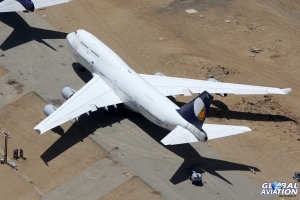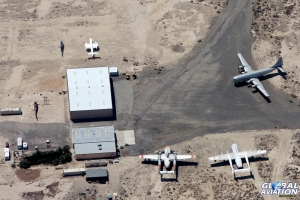In a follow up piece to his recent Victorville blog, Paul Dunn presents some photos from a recent flight to Mojave Air and Space Port.

Having really enjoyed flying over Victorville and photographing the stored aircraft there, I was keen to repeat the experience over some of the other airports in the US where aircraft are stored and scrapped. High up on my list was Mojave, probably the best known of all the airfields which specialise in what is now known as ‘recycling’ of time expired airframes.
An opportunity to visit Mojave came about when I was rostered to work with a good friend of mine. Pete has his FAA license for light aircraft and is checked out on the C172 with Rolling Hills Aviation in Torrance, so we planned to hire an aircraft for the day and head off somewhere. Pete favoured going over to Catalina Island for some lunch, but I managed to talk him into something a bit more adventurous…
We met up with two other friends (Craig and Richard), piled into the little Cessna, departed Torrance and headed north towards LAX. We had hoped to do the low level ‘mini route’ transition over the airport, but it wasn’t available, so we had to route via the ‘Special Rules Airpace’; essentially the same route but slightly higher. The incredible thing was that you are allowed to fly over the largest and busiest airport on the west coast and YOU DON’T HAVE TO TALK TO ANYONE! That was quite a lot for us to take in!

We headed north towards the San Gabriel mountains at 5,500ft, just above a layer of cloud, which mostly obscured our view of the peaks. Once we got past the mountains and over the Mojave Desert, conditions improved tremendously. A shortish transit took us over Fox Field, within distant sight of Edwards AFB, to one of the most interesting airports in the area, Mojave Air and Space Port.

In addition to its role as a public airport, Mojave is well known for three activities – flight testing, space development and aircraft storage. The combination of these three fascinating aspects of aviation makes the airfield a very interesting place indeed. However, Mojave is not the friendliest airport to the photographer – there’s lots of no photography signs etc. on the ramp, and they don’t run tours of the airfield any more. This is mainly down to the fact that many of the activities which take place on the airfield are commercially sensitive, and the companies involved don’t necessarily like their advanced equipment being photographed by the public.
Despite this, we found the airfield quite quiet and ATC extremely helpful and pleasant! We’d planned for an overhead join for a right hand downwind to runway 26, touch and go, circuit and land. They initially offered us 08, which wouldn’t have been too helpful, but on request they approved my original plan.
This recently completed building houses Stratolaunch, a collaboration between Paul Allen and Burt Rutan to build a massive version of White Knight to launch satellites into orbit. The design features the longest wingspan of any aircraft built, and actually uses a lot of parts robbed from two ex-United 747-400s, including engines and avionics. One of the donor aircraft is seen outside the hangar where the aircraft will be built. The other has been heavily cannibalised such that it has passed into the scrapping area on the airfield.

Doing the same job on a smaller scale is Orbital Sciences, who operate what is apparently the only airworthy Tristar in the US.

The main reason for going to Mojave though was to shoot the stored airliners. There are two areas used for storage/reclamation. The area to the west of the airport has mainly recent arrivals, some of which may yet see service with other operators. The eastern area houses long term residents and is also the area where most of the scrapping seems to take place.

Dominating the eastern area at the moment is a lineup of Boeing 747-200/300 freighters last operated by Southern Air. The company has now retired the majority of its fleet of Classic Jumbos in favour of 747-400s and 777Fs.

Along with the Southern Air examples, there are also several former Atlas Air jets, which have also now been replaced by newer aircraft. It would appear that these aircraft are not expected to fly again, and in most cases there are already plenty of missing parts.

The area behind the line up of 747s contains a huge variety of old (and some very old) machines; each time I look at the photos I spot something new!

Short final for runway 26 gave a good view of the final destination for the majority of the Aero California fleet of DC-9s, which were withdrawn when the airline ceased operations in 2008.

The western side of the airfield contains further interesting aircraft, many of which are in considerably better condition than those on the east. These include more ex-Southern Air 747s, both dedicated freighters rather than converted passenger jets.

This 747 still carries the colours of Saudi Cargo, but is in fact another ex-Southern Air machine, which spent the final part of its career leased to the Saudi operator. The fact that these aircraft are in good condition and kept separately from the rest of the fleet makes me wonder if there is a chance that they may be sold for further service rather than scrapped.

The west side of the airfield is dominated by a large number of DC-8 freighters recently retired by cargo operator ATI. Most of these are stretched DC-8-71/73F versions, fitted with CFM56 engines, but there is one DC-8-62F to be seen too.

Downwind for runway 26, and once again we got a good view of the eastern storage area. There are two former USAF C-133 Cargomasters languishing in the corner; these aircraft supplied spares to the final airworthy example which until 2008 flew occasionally from Anchorage’s Ted Stevens International Airport. When this aircraft was retired, the two examples at Mojave became surplus and were to be scrapped. This hasn’t happened as yet and the aircraft are still clinging to life, albeit in fairly poor condition.

After landing, we taxied to the transient parking area, shut down and headed inside for some lunch. After eating in the excellent airport restaurant, we decided to walk to the main gate to look at the Convair 990 and F-4 Phantom on display there; it turned out to be a much longer walk than we had anticipated, especially in the midday sun, but it was interesting to look around the aircraft, especially the impressive Convair.

When we got back to the terminal we had to stop for a cold drink to recover! While we were in the restaurant, Scaled Composites’ White Knight Two was towed from its hangar; a couple of days later it was reported that this aircraft had carried Space Ship Two aloft for its first powered flight.

After take off we requested a right hand 270 degree turn to depart to the south, which was approved by ATC, which gave us another look at the western storage area. There are 13 DC-8s in this shot.

This MD-11F (N384WA) has an interesting, if somewhat sad, history. It was built as a passenger aircraft and originally delivered to Varig in 1991 and registered PP-VOQ. In 1994 it had the solemn duty of returning the body of Ayrton Senna to his native Brazil after his untimely death at the San Marino Grand Prix. It was later converted to a freighter for Gemini Cargo and later passed to World Airways before being placed in storage.

Whilst most of the 747s in storage are -100/200/300 series ‘Classics’, there are a few -400 series to be seen too, including this former Lufthansa example.

A pair of former TNT Airbus A300s – a sad sight for me, I clearly remember regularly parking alongside one of these at Milan Linate Airport in the early years of the last decade.

This pair of BAC1-11s were once operated as trials aircraft by Northrop Grumman. The company retains a couple of aircraft to this day.

White Knight Two on the ramp, being prepared for its imminent milestone flight.

And finally, as we left the area, a shot of the two gate guards.

We retraced our previous route back towards the LA area, flying over this house en route – some interesting bits and pieces in the back yard!

We also managed to fly over the Milestones of Flight Museum at Fox Field, Lancaster.

Eventually, after some sightseeing, we returned to Torrance and shutdown.

It had been an excellent day out, and it wasn’t quite over yet – the EAA’s B-17 Flying Fortress ‘Aluminum Overcast’ was in town to give flights over the next weekend, so a couple of shots on the ramp were in order before heading for some food and a few beers to finish the day off.

There was also a lovely P-51D Mustang in one of the T-hangars.

A fascinating day out, with great company too. As with Victorville, it’s always sad to see old aircraft in poor condition, but always impressive and certainly interesting. I was particularly sad to see the ex-Southern Air 747s, as I had shot several of the in Alaska a few years ago. Still, time waits for no man… I must thank Pete, Richard and Craig for making it such a fun day, especially Pete for doing the flying! TTFN.




























Get involved – join the conversation?